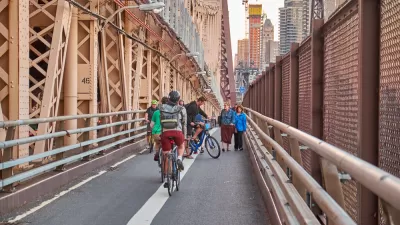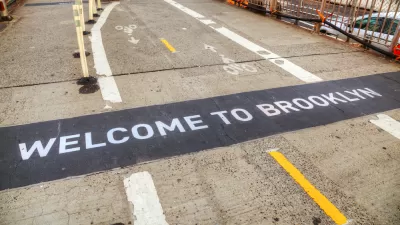The city plans to make conditions safer for bikes and pedestrians on and around the Brooklyn Bridge bike lane, which opened to much fanfare—and some disappointment—last year.

A Streetsblog NYC article details the New York City Department of Transportation’s efforts to improve the highly anticipated Brooklyn Bridge bike lane, which disappointed some bike advocates when it opened last year.
“Currently, the stretch of Centre Street north of Worth Street is what cyclists call ‘The Sluice’ because it resembles an entry path into an abattoir. Both curbside lanes of the roadway are occupied with placarded court and law enforcement cars.” According to the article, “The slaughterhouse conditions continue northbound on Centre Street to Canal Street. But the roadway definitely does not get safe above Canal. Yes, there is less double parking, but frustrated drivers tend to speed above Canal, where Centre opens up to two wide, rarely obstructed lanes.” Due to these conditions, “Since January 2017, there have been 64 reported crashes on just the two-block stretch of Centre Street between Canal and Grand streets, injuring eight cyclists, three pedestrians and two motorists.”
Now, “Work is under way to extend the Brooklyn Bridge protected bike lane on Centre Street north of Worth Street all the way to Kenmare Square and add a downtown-bound protected bike lane on Lafayette Street south of Kenmare Square, which currently has a painted lane.” Additionally, “The city will cut the motor vehicle lanes on Centre Street from two down to one in the section between Worth and Canal, and had previously said it would install pedestrian island[s] at every intersection along the way (some of those have already been blocked out).”
The plan doesn’t address every issue: “The only thing missing from this gap-closing plan is a better solution for cyclists who want to ride between the Brooklyn Bridge bike path and points west, including the hugely popular Hudson River Greenway.”
FULL STORY: Eyes on the Street: The Dawn of a Better Brooklyn Bridge Bike Lane!

Alabama: Trump Terminates Settlements for Black Communities Harmed By Raw Sewage
Trump deemed the landmark civil rights agreement “illegal DEI and environmental justice policy.”

Planetizen Federal Action Tracker
A weekly monitor of how Trump’s orders and actions are impacting planners and planning in America.

The 120 Year Old Tiny Home Villages That Sheltered San Francisco’s Earthquake Refugees
More than a century ago, San Francisco mobilized to house thousands of residents displaced by the 1906 earthquake. Could their strategy offer a model for the present?

In Both Crashes and Crime, Public Transportation is Far Safer than Driving
Contrary to popular assumptions, public transportation has far lower crash and crime rates than automobile travel. For safer communities, improve and encourage transit travel.

Report: Zoning Reforms Should Complement Nashville’s Ambitious Transit Plan
Without reform, restrictive zoning codes will limit the impact of the city’s planned transit expansion and could exclude some of the residents who depend on transit the most.

Judge Orders Release of Frozen IRA, IIJA Funding
The decision is a victory for environmental groups who charged that freezing funds for critical infrastructure and disaster response programs caused “real and irreparable harm” to communities.
Urban Design for Planners 1: Software Tools
This six-course series explores essential urban design concepts using open source software and equips planners with the tools they need to participate fully in the urban design process.
Planning for Universal Design
Learn the tools for implementing Universal Design in planning regulations.
Clanton & Associates, Inc.
Jessamine County Fiscal Court
Institute for Housing and Urban Development Studies (IHS)
City of Grandview
Harvard GSD Executive Education
Toledo-Lucas County Plan Commissions
Salt Lake City
NYU Wagner Graduate School of Public Service




























